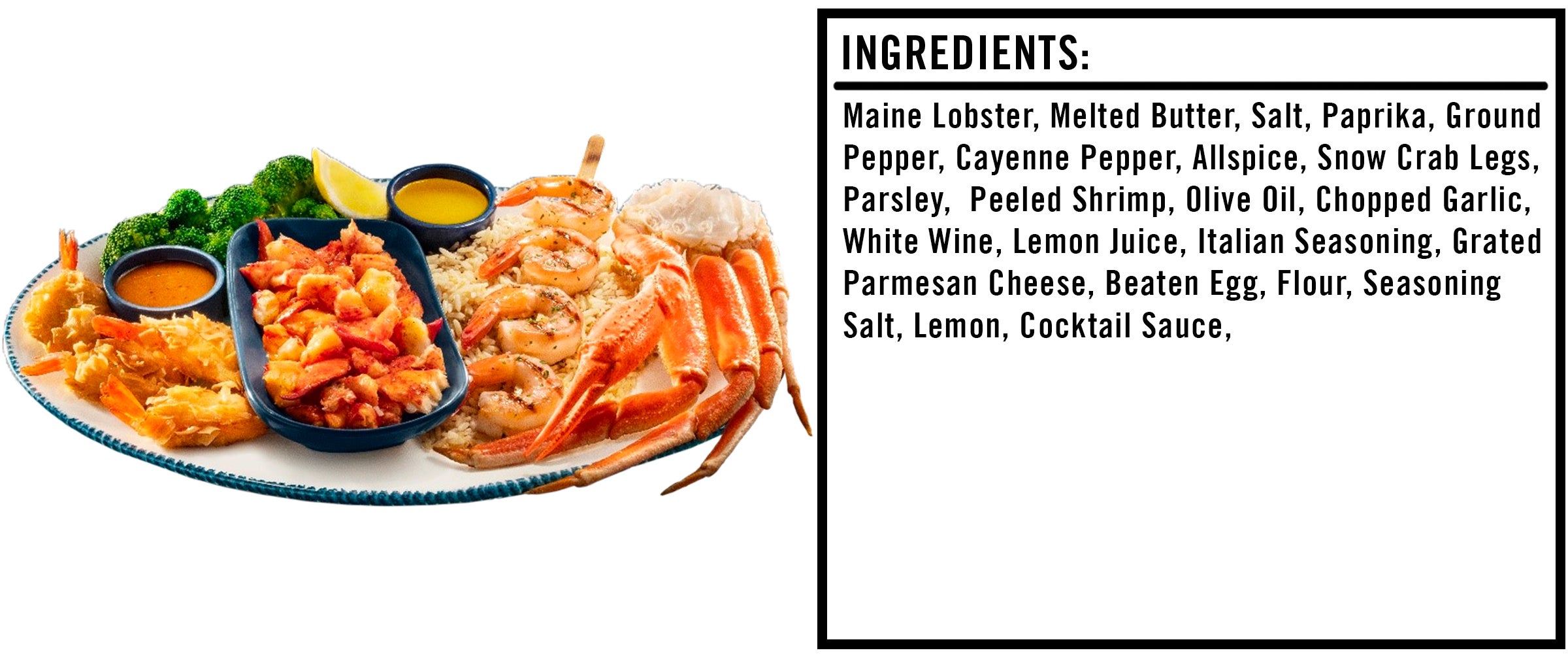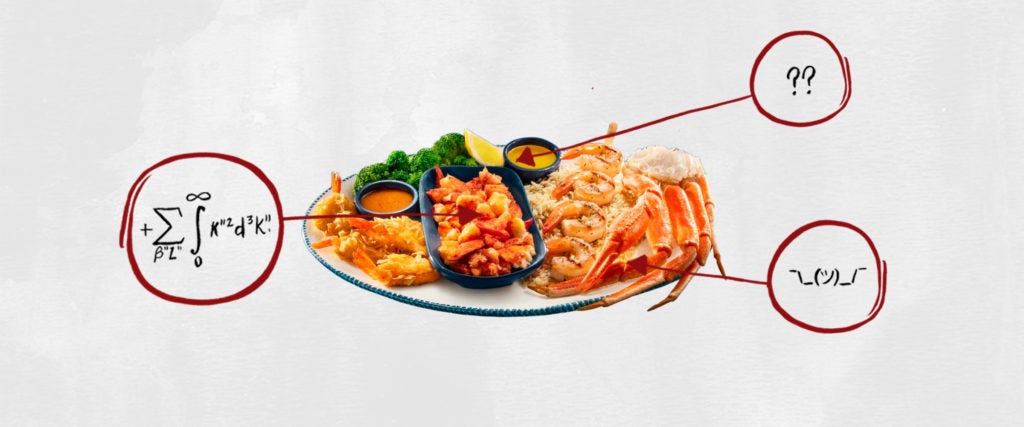The post-high-school-graduation family party wouldn’t be the same without Red Lobster. Since it originated in 1968 (in Florida of all places!), the New England-themed restaurant chain has enabled entire families to pretend that they were enjoying a fine-dining seafood experience. Along the way, it’s curiously distinguished itself as one of the most unlikely staples of the African-American experience.
The modern Red Lobster menu is flush with feasts of various varieties, all of which are likely to leave you repeatedly flushing the toilet as you cope with the aftermath of your overindulgence. However, if Highlander taught me anything — aside from the fact that I never really needed to see Sean Connery get decapitated on-screen — it’s that there can only be only one. And in the case of the Red Lobster menu, that’s the Ultimate Feast.
Let’s take a gander at this prodigious pile of decapods to see if this feast is a beast that might leave you deceased!

Tender Maine Lobster Tail
Maine Lobster: This denizen of Northeastern U.S. waters is the signature item on the Red Lobster menu, and like all shellfish, it’s going to flood your meal with cholesterol in a jiffy. Fun fact: The Maine lobster is the exact same species (Homarus Americanus) as the Canadian and Australian lobster varieties, with the physical differences between the types being dependent upon the environments in which they spawned. Maine lobsters have thinner shells and sweeter flesh and can survive for 48 hours out of the water, while their Canadian counterparts have thicker shells, and flesh that is less sweet, but can survive for 24 more hours outside of the water than their cousins from Cabot Cove.
Melted Butter: Assuming Red Lobster is doing things correctly, this should be clarified butter, which is composed of butterfat left over after the milk solids and water are removed, revealing a purer form of butter with a higher smoke point.
Salt: This Ultimate Feast is going to be the ultimate source of sodium by the time we’re done counting. Just you watch.
Paprika: Derived from the same family as chili peppers, paprika usually provides mild heat to food, along with some sweetness. Ironically, paprika is purported to be an appetite suppressant, which means that if you’d theoretically consumed enough of it before it was time to order your entree, you wouldn’t have felt compelled to drop 30 bucks on the Ultimate Feast in the first place.
Ground Pepper: The ubiquitous black pepper present at all kitchen tables is alleged to have cholesterol-combating properties. We’re going to revisit this paradox later.
Cayenne Pepper: The powdered form of this spicy red pepper is here to bring the heat. Medicinally, cayenne has been considered helpful to the digestive system for centuries, but as my mother always warned me in her Bahamian dialect, “Don’t eat too much, or it’ll burn ya boongie, bey!”
Allspice: It may sound like this is a literal amalgamation of all spices, but allspice is actually a single herb that combines the flavors of cinnamon, nutmeg and cloves.
Wild-Caught North American Snow Crab Legs
Snow Crab Legs: Typically caught in cold waters, the snow crab is also known as the “queen crab” and the “spider crab.” I can understand why the name “snow crab” is used here, though; people might be less inclined to dine on the legs of an arachnid.
Unsalted Butter and Parsley (dip): There’s less of a traditional requirement that this should be clarified butter, so we’ll assume it’s regular butter with the water and milk solids remaining. Parsley is the green garnish that people scrape away from their entrees, which is sad because it’s a very rich source of vitamin K, a critical micronutrient that helps your blood to clot.
Parsley (garnish): Okay, this is the version that you will tragically scrape aside to get to the seafood.
Hand-Crafted Garlic Shrimp Scampi
Peeled Shrimp: Per Red Lobster’s website, all of its shrimp are “eco-certified by a third-party program or engaged in a credible Fishery Improvement Project or Aquaculture Improvement Project.” Unfortunately, to this day, I can’t eat shrimp without thinking about a particular scene from Tommy Boy.
Olive Oil: Not to be confused with Popyeye’s lady love Olive Oyl, this form of cooking oil is so popular that 90 percent of all olives farmed in the world are reserved for its production. (I also have it on good authority that an olive oil company can double as an impenetrable front for your mob operation.)
Chopped Garlic: We’re assuming this is fresh garlic, which has a number of interesting effects on your body. For instance, it can help you lower your cholesterol (more on this later), and amusingly, it can also reduce blood clotting (so I guess you need to eat the parsley to offset this). It’s also the source of Wario’s superhuman flatulence. Let’s just hope Red Lobster never resorts to using minced garlic from a jar, because the taste certainly isn’t the same.
White Wine: The white wine used in cooking typically has a high level of acidity. We don’t know which of the many white wines Red Lobster includes in the shrimp scampi, but those attempting to replicate the recipe on their own have suggested using a dry Chardonnay. Fun fact: Unless dishes containing alcohol are cooked for at least three hours, there’s still a better-than-average chance it will contain active alcohol content when you consume it.
Lemon Juice: If this is freshly squeezed, then that’s awesome. If not, it probably contains fun stuff, including a preservative like sodium benzoate, and lemon oil, which is pressed out of lemons to provide a concentrated burst of lemon flavor.
Italian Seasoning: This rustic seasoning blend commonly includes oregano, basil, thyme and rosemary, and has a number of health benefits attributed to it as a result of the combined efforts of all of those herbs.
Softened Butter: This is butter that’s been kept at room temperature, and is more than likely regular butter.
Parsley: This time it’s in the sauce, so you can’t avoid the vitamin K.
Grated Parmesan Cheese: Fortunately, Red Lobster grates the cheese themselves and doesn’t sprinkle it straight out of a Kraft shaker. Parmesan is aged for at least three months, which grants it a richer flavor than other cheeses.
Walt’s Favorite Shrimp
Shrimp: Larger versions of the shrimp used in the garlic shrimp scampi.
Oil: It could be any number of different cooking oils if no specification is provided, and it does make a difference which one is used, because oils have varying smoke points, and can increase the prevalence of free radicals in your body.
Beaten Egg: Simply the standard, unfertilized embryo of a chicken. It’s probably a white egg, not that it makes a difference.
All-Purpose Flour: Just your standard combination of hard and soft wheats. This provides the foundation of the batter for the breading. Personally, I’d rather use it to bake a Bahamian Johnny Cake.
Seasoning Salt: This is salt, usually served up in a combination that includes garlic, onion and paprika.
Salt: Apparently there wasn’t enough actual salt in the seasoning salt to satisfy the insatiable need for sodium. It’s really starting to pile up!
Lemon: We’re assuming you’re not going to eat the lemon, and that you’re just going to squeeze the juice from it onto the shrimp. If you’re one of those people who actually does like to eat lemons, you’re going to receive a high dose of vitamin C and only a few additional calories.
Cocktail Sauce: A combination of ketchup, horseradish, hot sauce, Worcestershire sauce and lemon juice. You almost wonder who had the nerve to combine three very well-established sauces together, then add horseradish and lemon juice and decide it was it’s own thing. Well, that remains a mystery, but it was first advertised and promoted as Oyster Cocktail Sauce in 1896, with Snider’s running the first national advertisement for it — with its traditional ingredients listed — in 1903. So, yeah, blame them.

The Takeaway
Egads! The ultimate irony of this aquatic agglomeration is the fact that so many of the ingredients are legitimately of a health-sustaining variety, only for it all to go for naught behind the sheer volume of this seafood dreadnought. We still haven’t ordered an appetizer, a drink or either of our two sides yet, and we’re already north of 1,000 calories, 4,420 milligrams of sodium (nearly double the recommended daily dose) and nearly one-and-a-half times the recommended daily intake levels of saturated fat and cholesterol. It’s like the seasonings are at war with the food items they’ve been placed upon, and believe me, the food is winning.

